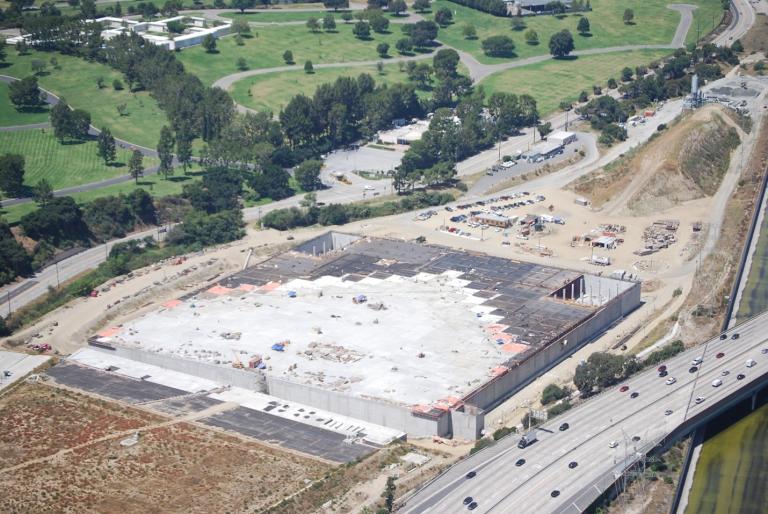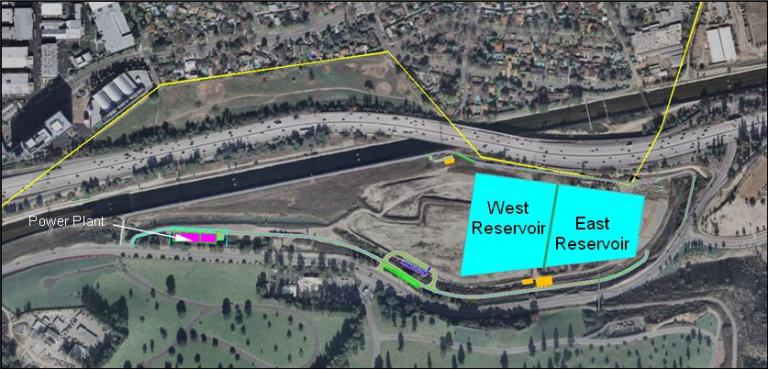
Project Background
Three decades ago, the LADWP recognized the need to begin making changes to its open reservoir system due to emerging State and Federal water quality regulations.
The new underground Headworks Reservoir will replace the Silver Lake and Ivanhoe reservoirs located at the Silver Lake Reservoir Complex, for the purposes of safeguarding and improving drinking water quality.
Compliance With State and Federal Water Quality Regulations
To comply with increasingly more stringent state and federal regulations, the LADWP has been required to make major changes to its open reservoir system. These regulations include the Stage 2 Disinfectants and Disinfection Byproducts Rule and the Long Term 2 Enhanced Surface Water Treatment Rule.
1. Stage 2 Disinfectants and Disinfection Byproduct Rule
Chlorine used to purify water can react with naturally occurring organic material and produce trihalomethanes (THMs). THMs, in significant doses, have been shown to increase the risk of cancer in laboratory animals. With the higher level of algae and other organic materials in the reservoir, the potential to form THMs is greater. The Stage 2 Disinfectants and Disinfection By-Products Rule requires compliance with maximum contaminant levels (MCL) of 80 parts per million (ppm) for Total THM and 60 ppm for haloacetic acids (HAAs). The MCLs must be met at each compliance sample location. Previously, utilities could average all THM and HAA values to obtain one system-wide average.
2. Long Term 2 Enhanced Surface Water Treatment Rule
The Long Term 2 Enhanced Surface Water Treatment Rule addresses covering existing reservoirs and/or providing increased protection from microbial pathogens. Reservoirs in the LADWP system must comply with this regulation which requires the following:
- Cover the reservoir, or
- Achieve 99.99% (4-log) inactivation or removal of viruses
In order to comply with these two regulations, the LADWP has covered, bypassed, or setup downstream treatment for each of its open reservoirs.
Open reservoirs in Los Angeles, including Silver Lake and Ivanhoe, stored drinking water from the Los Angeles Aqueduct, the Metropolitan Water District, and groundwater sources. The treated water that entered the open reservoirs was exposed to contamination from surface runoff, birds, insects, animals, and humans. Also, sunlight and elevated temperatures, especially during the summer months, contributed to the growth of algae that degrades water quality and increased taste and odor problems. These problems have been eliminated by covering, bypassing, or setting up treatment downstream of these reservoirs.
Now that the Silver Lake and Ivanhoe Reservoirs have been bypassed, they are no longer utilized as a source of potable water. Rather, they are being maintained as non-potable water bodies for the continued benefit of the community.
Project Scope
In order to meet these two regulations, the LADWP has planned to construct the following facilities at the Tom LaBonge Headworks Water Complex:
- Two buried reservoirs with a combined storage capacity of 110-million gallons
- Flow Control Station
- Direct Potable Reuse Demonstration Facility
- Headworks Water Quality Laboratory
- Headworks Restoration Project

1. East and West Reservoirs
- The largest underground drinking water reservoirs in the Western United States
- Buried reservoirs are sized to store 110 million gallons in total capacity.
2. Flow Control Station
- This facility will regulate the flow coming through the new RSC Upper Reach into the reservoirs
- The flow control station will have a capacity of 250 cubic feet per second and is one of the largest in LADWP’s System.
3. Headworks Restoration
- Restoration may include a passive use park on top of the west reservoir, parking/turnaround area, pavilion, restrooms, bicycle path, and informational areas that will educate visitors on the critical infrastructure that supports the City of Los Angeles.
4. Direct Potable Reuse Demonstration Facility
- The purpose of this facility is to provide advanced water purification of recycled water from the Los Angeles-Glendale Water Reclamation Plant.
- This project has multiple phases, including an initial pilot which is currently in development. At each step LADWP will be working closely with the California Division of Drinking Water to demonstrate that through this advanced treatment we are able to meet stringent water quality regulations.
- Eventually, the goal is to supplement our potable water supply with this advanced treated water and is a important step towards implementation of Pure Water Los Angeles.
5. Water Quality Lab
- The Water Quality Lab will replace the existing lab located in Pasadena, California with a centrally located, state-of-the-art facility. The lab will provide approximately 100,000 square feet of lab space and offices.
Project Timeline
| Type | Item | Date and / or Range |
| Completed Items | Headworks Reservoir East Construction | 2014 |
| Headworks Reservoir West Construction | 2022 | |
| Construction Phase | Flow Control Station | 2019 to 2025 |
| Headworks Restoration | 2027 to 2029 | |
| Water Quality Laboratory | 2027 to 2030 | |
| Direct Potable Reuse Demonstration Facility | 2029 to 2031 |
Environmental Documentation
Environmental Impact Report
The Silver Lake Reservoir Complex (SLRC) Storage Replacement Project was assessed in accordance with the California Environmental Quality Act (CEQA). LADWP submitted a Notice of Preparation (NOP) for the SLRC Project to the state Clearinghouse on August 22, 2003, initiating a public scoping period which concluded on September 24, 2003. Comments received during the public scoping period were considered by the LADWP during the preparation of the Draft EIR for the SLRC Project. A Draft EIR was prepared that describes the potential environmental impacts associated with the SLRC Project and identifies mitigation measures intended to reduce project impacts. The Draft EIR was released for public review, and the 45-day public review period concluded on September 19, 2005.
A Final EIR for the SLRC Project was subsequently prepared and adopted by the Los Angeles Board of Water and Power Commissioners.
Mitigated Negative Declaration
Draft Mitigated Negative Declaration
LADWP, in accordance with CEQA, has developed a draft Initial Study/Mitigated Negative Declaration (IS/MND) to evaluate the potential environmental impacts for the Headworks Site Development Project. LADWP proposes to develop three facilities within its existing Tom LaBonge Headworks Water Complex. The facilities would include a Water Quality Laboratory (WQL), a Direct Potable Reuse (DPR) Demonstration Facility, and a public park (Headworks Restoration Park), which are the components of the Headworks Site Development Project. The purpose of the WQL is to replace the existing obsolete LADWP laboratory facility, which is located in the City of Pasadena. The purpose of the DPR Demonstration Facility is to test various water purification technologies for treating recycled wastewater to help the City of Los Angeles meet the goal to recycle all of its wastewater for beneficial reuse by 2035. The purpose of Headworks Restoration Park is to provide recreational access and educational opportunities regarding local ecosystems and water use. The proposed project would also include roads interior to the HWSG property, surface parking for staff and visitors, landscaping, and security lighting and fencing where required.
The Draft IS/MND was circulated for public review on April 25, 2024. The 30-day public review period concluded on May 28, 2024. The Los Angeles Board of Water and Power Commissioners will consider a Final IS/MND at a to-be-determined Board of Commissioners meeting.
Contact Information
Project Manager (East Reservoir | West Reservoir | Flow Control Station | Restoration)
Christopher Munis, MBA, PE
(213) 367-2412
[email protected]
Project Manager (Water Quality Lab)
Ani Siyahian, PE
(213) 367-3841
[email protected]
Project Manager (Direct Portable Reuse)
Meghrie Demirdjian, PE
(213) 367-0043
[email protected]
Community Affairs
Michael Ventre
(213) 367-1381
[email protected]